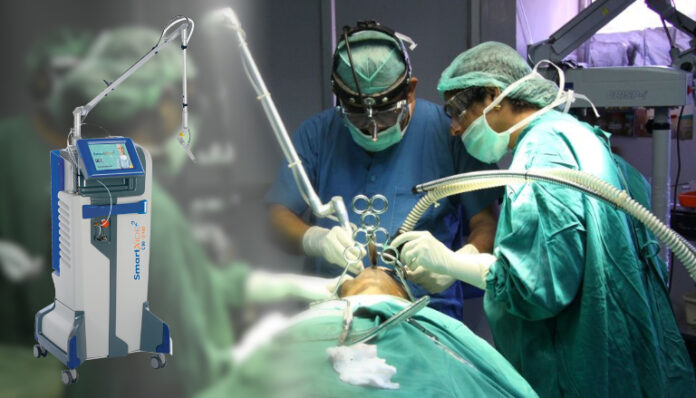Significance of the ENT Laser Devices
ENT Lasers are also widely called CO2 lasers. CO2 laser surgery is implemented popularly worldwide in Otolaryngology for the treatment of throat, ear, and nose, disorders. It is regarded as a minimally invasive surgery (MIS) with high speed, perfect precision, & minimal side effects. It can also be implemented by the elders by installing the pacemakers in their hearts. The ENT Laser Devices Market size is expected to rise up to USD 110.12 million throughout the estimated time frame of 2020-2028, with a total CAGR of 6.73 %.
However, Laser technology has gained worldwide popularity, especially in the sector of healthcare & which is growing steadily with a CAGR value of 8.73% throughout the prevised timeframe. In the United States, around 54000 people were diagnosed with oral cancer in 2020, which caused more than 9750 fatalities, killing roughly one person per hour. In addition, in one of its reports, the American Cancer Society widely stated that there will be almost 12,960 total cases of laryngeal cancer in the United States in 2021, which will result in almost 3770 deaths in the country.
On the other hand, the Cosmetic ENT Surgeries have gained a significant level of popularity across the globe & are likely to cater to ample growth opportunities in the future. In 2020, there were around 13.3 million cosmetic minimally invasive procedures performed all around the world.
Key Market Drivers for ENT Surgery Lasers
Minimally invasive operations have become more popular as a result of technological developments in ENT surgery. Lasers are increasingly being used in numerous ENT applications. ENT specialties such as ear, nose, larynx, and neck surgery have embraced laser technology.
Diode lasers, which were recently introduced, have a number of advantages over (CO? ), Nd: YAG lasers, and argon lasers. Diode lasers also reduce blood loss and eliminate the need for blood transfusions.
Tonsillectomy, bleeding from the nose, turbinate reduction, polyps, nasal obstruction, septal surgery, Laser-assisted uvulopalatoplasty (LAUP) for snoring, leukoplakia, and oral lesions are some of the indications for diode lasers in outpatient surgery.
The availability of minimally invasive medicines is projected to grow in both developed and developing countries.
Endoscopic laser lithotripsy is a minimally invasive method for removing big salivary stones from ducts, as opposed to transoral scialectomy or external sialoadenectomy.
Global ENT Surgery Lasers Market Restraints
The market for ENT surgery lasers is anticipated to be constrained by regulatory regulations. It’s crucial to follow a number of safety standards and regulations when it comes to laser items. Laser safety regulations differ from one jurisdiction to the next.
Before commercialising laser equipment in the United States, laser manufacturers must obtain certifications and approvals from the Center for Devices and Radiological Health (CDRH) and the Food and Drug Administration (FDA).
Some of the rapid advancements in the ENT Laser devices can be seen through the introduction of Gas Lasers and Solid and Semiconductor-Based Lasers.
a.) Gas Lasers
- CO2 Laser: It produces a simultaneous and continuous wave of coherent lights at a wavelength of around 10600 nm, which is absorbed well by the water and soft tissues.
- Argon Laser: It is produced by Argon gas with blue or green visible light ranging around (488-514) nm.
b.) Semiconductor-Based Lasers
Their applications of the semiconductor lasers are extremely widespread & include optical data storage, metrology, optical telecommunications, pumping of other lasers, spectroscopy, material processing, and medical treatments. Such characteristics make the semiconductor lasers the most important type of lasers prevailing in the current market.
CONCLUSION
Some of the most significant technological advancements in ENT surgery have led to a rising preference for minimally invasive surgeries. The usage of lasers in various ENT applications has increased widely. However, laser technologies have gained ground in ENT specialties, like surgery on the nose, larynx, ear, and neck. The recently introduced diode lasers have a plethora of advantages as compared to that the argon lasers. Diode lasers are also held to minimize blood loss & avoid blood transfusion.
In outpatient surgery, diode lasers are widely used for a number of indications, such as bleeding from the nose, tonsillectomy, polyps, nasal obstruction, turbinate reduction, septal surgery, leukoplakia, Laser-assisted uvulopalatoplasty (LAUP) for snoring, & oral lesions. The availability of the MI (minimally invasive) therapies in the various developed & developing countries is likely to increase the overall demand for ENT surgery lasers around the world. Endoscopic laser lithotripsy is regarded as a minimally invasive alternative to that of the transoral sialectomy or external sialoadenectomy procedures, indicated especially for the removal of the large salivary stones from ducts.


